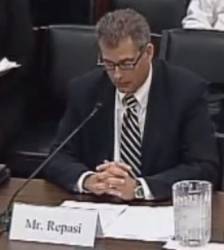Yesterday (December 23, 2016) President Obama signed the National Defense Authorization Act (NDAA) for Fiscal Year 2017, a $619-billion bill with a number of provisions affecting satellite navigation.
The legislation (S. 2943) fully authorizes the administration’s requests for all the elements of the GPS program — and signals indirectly that appropriators eventually will provide comparable support — although the NDAA does put additional requirements on those developing the new GPS ground system.
Yesterday (December 23, 2016) President Obama signed the National Defense Authorization Act (NDAA) for Fiscal Year 2017, a $619-billion bill with a number of provisions affecting satellite navigation.
The legislation (S. 2943) fully authorizes the administration’s requests for all the elements of the GPS program — and signals indirectly that appropriators eventually will provide comparable support — although the NDAA does put additional requirements on those developing the new GPS ground system.
The bill also throws congressional support behind development of a GPS backup and limits the use of signals from other satellite navigation constellations — a significant consideration given that defense officials have said using non-GPS satnav signals was one way to help assure service in an increasingly hostile space operations environment.
"There’s just too much in it, and not enough controversy to warrant a veto," Mike Tierney, vice president at Jacques and Associates a consulting firm that specializes in defense, space/intelligence, homeland security and related industries, told Inside GNSS. Congress had already left town, expecting that the bill would be signed.
Obama had few grounds for complaint where the GPS program is concerned. The NDAA authorizes all of the spending the White House requested for the various elements in the GPS program: $141.89 million for GPS III satellite development and $34.06 million for GPS III procurement plus $278.15 for development of Military GPS User Equipment (MGUE) and $393.27 for development of the Next Generation Operational Control System (OCX) and the GPS Enterprise Integrator.
The actual funding for FY17 in the form of an appropriations bill has yet to be approved, however — although that is not a bad thing for the GPS program. Congress passed a continuing resolution, signed into law December 10, which allocates money at FY16 levels through April 28, 2017. This actually gives GPS managers a good bit of latitude because each of the GPS programs, except OCX, got more money in FY16 than was requested for FY17 — and even OCX was funded at a not-too-shabby level of just over $350 million.
Prospects for Full Funding
OCX faced a much tougher battle for continued support this year with Senate authorizers withholding monies until the Pentagon declared a breach of the Nunn-McCurdy law. The Air Force went to the mat for OCX after finally declaring that breach over the summer while Senate appropriators sought independently to terminate the program.
Tierney says the policy tea leaves now suggest that full funding will arrive for all of the GPS programs, including OCX, although there a springtime vote remains to be held on funding that will likely take place after the new administration takes charge. Indications throughout the bill, he said, suggest that the staff of the House Armed Services Committee and Senate Armed Services Committee have coordinated with their counterparts on the appropriations committees to come to an overall agreement on funding levels and policy.
"There are instances where the conference position in the NDAA is neither the House position nor the Senate position from their original consideration earlier in the cycle," Tierney explained. "And, in fact, there are several instances where the final position in the defense authorizing conference adopts one of the positions taken by the appropriating committees. That is a sign that the defense authorization has been coordinated, at least on certain policy issues and funding levels, with the appropriators," he said.
So, he added, despite the fact that Senate appropriators tried to cut monies for OCX earlier this year, the full funding given OCX in the final, apparently coordinated authorization bill suggests full funding will appear in the appropriations bill as well.
The fact that OCX is fully funded in the authorizations bill, he said, "is a very positive sign that the ultimate appropriations bill, which will come before the end of April next year, will not cut the OCX program," Tierney said.
That doesn’t mean that Congress is sanguine about the outlook for OCX. The bill orders the secretary of defense to enter into an agreement within 90 days with a federally funded research and development center, or other appropriate independent entity, to assess the Air Force’s OCX acquisition strategy. Congress wants a report back in a year on the budget, schedule, and risk-reduction options as well as an opinion on methods for shutting it down.
Frequency Protection, GNSS, and a Backup
Congress also addressed the controversy between the GPS community and Ligado — and any other future users of the 1525–1559 MHz and 1626.5–1660.5 MHz bands. Would-be broadband provider Ligado is seeking to use portions of that spectrum, which neighbors the satellite navigation frequencies.
Without calling out the Virginia-based company by name, lawmakers forbade terrestrial operations on those frequencies, which are now allocated for satellite use, until 90 days after the Federal Communications Commission explains to Congress how possible interference with military GPS receivers had been resolved. The of defense secretary is also supposed to report every 90 days on instancers of interference to military receivers and whether that interference was caused by commercial communications services.
Congress enacted other limits as well — but in this case on the military.
Though Congress did not flatly prohibit the Defense Department from using signals from non-GPS constellations, it did proscribe by name the use of Russia’s GLONASS and China’s BeiDou signals. The secretary of defense can "waive the prohibition" or if it is in the national security interests of the United States it is necessary "to mitigate exigent operational concerns." More interesting, perhaps, is the report to be prepared by the secretary of defense, the chairman of the Joint Chiefs of Staff, and the director of national intelligence on the risks to national security involved in using non-allied positioning, navigation, and timing (PNT) systems, including the potential for interference with GPS as well as for espionage, counterintelligence, and targeting.
Finally, the conferees directed the secretaries of the federl departments of defense, transportation and homeland security to report back to lawmakers within a year with the results of a study assessing and identifying the technology-neutral requirements "to backup and complement the PNT capabilities of the Global Positioning System for national security and critical infrastructure."
That report must, among other things, lay out the options and analyze the viability of a public-private partnership for establishing a backup PNT system. The agencies are supposed to estimate their costs and schedule as well as the technical ramifications for their operations like the impact on equipment and integration. Finally the agencies are supposed to identify "the appropriate resourcing" — the key element that has been holding up procurement of a backup for years.






